Spatial Compatibility of Landscape Character State Assessment and Development Projects at County Scale: The Case of Songzi City, China
Abstract
1. Introduction
2. Materials and Methods
2.1. Research Subjects
2.2. Data Sources and Methodological Content
2.2.1. Identification of Landscape Characters
2.2.2. State Cognition of Landscape Characters
- (1)
- Landscape character state indicators
- (2)
- State cognitive practice approach
- (3)
- State cognitive awareness questionnaire
2.2.3. Character Evaluation Based on Specific Construction Projects
- (1)
- Selection of specific construction projects
- (2)
- The method of expert participation and questionnaire design
- (3)
- Calculation of the coupling degree of specific construction projects
- (4)
- Deployment evaluation model for specific construction projects
3. Results
3.1. LCA Distribution and Status
3.2. Analysis of Expert Evaluation Results
3.2.1. Results of the Evaluation of Leisure Agriculture Judgment
3.2.2. The Results of the Evaluation of Grid Facility Judgment
3.2.3. Energy Facility Judgment Evaluation Results
3.3. Planning Layout of Specific Construction Projects
3.3.1. Leisure Agriculture Layout
3.3.2. Grid Facility Layout
3.3.3. Energy Facility Layout
4. Discussion
4.1. Integrated Structures and Cultural Factors for Landscape Character Identification
4.2. The Practical Value of State Cognition
4.3. Project-Specific Planning and Control Strategies
- (1)
- Leisure agriculture. Leisure agriculture needs to be combined with the LCA characteristics of the planning layout; the landscape character base map helps in the formation of the landscape characteristics of each village for the excavation of a village landscape and village group development and to ensure to carry out the integrity of the zoning and grading of the scope of the care provided by the basis [8]. Leisure agriculture relies on rural scenery, agricultural facilities, farming culture, and other agritourism resources to meet tourist infrastructure and aesthetic needs [33]. The coupling degree of rural landscape character and leisure agriculture realizes the possibility of village preference from the county scope and screens out villages with beauty and adaptability, as well as the possibility of transformation from the perspective of a more comprehensive mutual game between multiple indicators. On this basis, consideration of leisure agriculture and cultural corridors will highlight the point degree effect of each preferred point to form a linkage with the surrounding tourist attractions and strengthen the overall layout structure and function of leisure agriculture, which will be conducive to the continuation and development of the beautiful countryside landscape.
- (2)
- Grid facilities. Power grid facilities are the most important linear infrastructure in the countryside, and the scale is expressed as a corridor and a network that provides basic power protection for villagers’ production and life and maintains the normal operation of landscape facilities. The location, area, scale, and lines of power facilities, which involve the use of land and spatial resources, should be arranged in planning, and the power grid needs to be adjusted to the natural and humanistic landscape environment [34], which has a significant impact on the continuity of rural landscape character. The continuous protection of landscape character contributes to the integrity of natural and human landscape elements in the region, as well as the continuation of the visual effect, and plays an important role in the survival and reproduction of species. The overall planning and layout should focus on not destroying the continuous distribution of features and integrating them with the surrounding landscape as much as possible.
- (3)
- Wind power generation facilities. The layout of wind power facilities is generally centralized and continuous, and their sites are selected based on the coupling and coordination between wind power facilities and landscape character states, in addition to other engineering and environmental factors [35,36]. Usually, areas with high values are selected so as to not damage the good state of landscape character in the countryside as much as possible, because the common point of these areas is that the diversity, visibility, and sense of wilderness of landscape character are low, and the impacts caused by wind power generation facilities will be relatively small, whereas the low value of aggregation is mostly in scenic areas, reservoirs, and other ecologically fragile areas, which show a strong conflict with the facilities and need to be treated with caution when planning and designing. The planning and design should be careful, and a certain buffer range should be considered. Furthermore, the form and direction of the landscape should be visually synchronized with the landscape character patches, mainly farmland, to avoid destroying the vast farming landscape. Wind turbines cover and weaken some characteristic vertical space landscape characters; thus, the scale should be coordinated with the volume of local landscape character patches and village building groups [37]. In addition, it is necessary to avoid visual discomfort [36].
5. Conclusions
- (1)
- Compared with regional large-scale rural landscape characteristics, which employ a desk-based, objective, and strategic planning research approach, the local scale represented by counties is practical. Thus, the LCA has specific characteristics. It emphasizes the introduction of human factors and the common results of natural factors in the identification stage, the combination of objective and sensory factors in the cognition of character states, and the combination of desktop surveys, subjective and objective data integration, and stakeholder participation in the judgment and evaluation stage.
- (2)
- The state cognition under the combination of subjective and objective factors enhances the understanding of LCs from inside to outside and from shallow to deep and provides the basis for the selection of indicators and judgment for the evaluation of the coupling and coordination of specific projects and LC states.
Funding
Data Availability Statement
Conflicts of Interest
Abbreviations
| LCA | landscape character assessment |
| LC | landscape character |
| LCAs | landscape character areas |
Appendix A
| Status Aspects | Status Indicators | Serial Number | Subjective Structure of Indicators | Objective Structure of Indicators | |
|---|---|---|---|---|---|
| Survey Records | Resident Questionnaire Record | Desk Calculation | |||
| Composition state | Color contrast | a1 | √ | ||
| Spatial hierarchy | a2 | √ | |||
| Sense of settlement boundaries | a3 | √ | |||
| Regularity | a4 | √ | |||
| Pattern state | Diversity | b1 | √ | √ | |
| Continuity | b2 | √ | √ | ||
| Attribute state | Accessibility | c1 | √ | √ | √ |
| Visibility | c2 | √ | √ | ||
| Intervisibility | c3 | √ | |||
| Disruptive | c4 | √ | √ | ||
| Wilderness | c5 | √ | √ | ||
| Entertainment | c6 | √ | √ | ||
| Quietness | c7 | √ | √ Decibel data | ||
| Security | c8 | √ | √ | ||
| Human–landscape interaction | c9 | √ | |||
| Human–landscape correlation | c9_1 | √ | |||
| Emotional state | c10 | √ | √ | ||
| Living level | c11 | √ | |||
| Sense of place | c12 | √ | √ | ||
| Rarity | c13 | √ | |||
| Attraction | c14 | √ | √ | ||
| Cultural | c15 | √ | √ | ||
| Questionnaire Items | Description | Village 1 | Village 2 | ...... | Village 88 |
|---|---|---|---|---|---|
| Identity/sense of place/sense of home | Strong, medium, weak, none | ||||
| Relaxation/peace/peace and serenity | Strong, medium, weak, none | ||||
| Sense of history/memory | Strong, medium, weak, none | ||||
| Recreational activities entertaining | Strong, medium, weak, none | ||||
| Religious practices and sense of spirituality | Strong, medium, weak, none | ||||
| Sense of security, well-being | Strong, medium, weak, none | ||||
| Aesthetic perception (attractiveness, mystery, beauty) | Strong, medium, weak, none | ||||
| Frequency of wildlife | Strong, medium, weak, none | ||||
| Types of ways to experience the landscape | Walking, biking, driving, public transportation | ||||
| Popular landscape elements | Description | ||||
| Unpopular landscape elements | Description | ||||
| Length of residence | Family living, dated, recent, newly moved in |
| Target Level | Standardized Layer | Indicator Layer | Basis of Judgment | Leisure Agriculture | Grid (High-Voltage Power Lines, Power Towers) | Energy Construction (Wind Turbines) |
|---|---|---|---|---|---|---|
| Status of LCAs | Constitutive state | Color contrast | The stronger the color contrast, the higher the value | None | ||
| Spatial hierarchy | The higher the horizontal and vertical spatial hierarchy of the landscape, the higher the value | −1 | ||||
| Sense of settlement boundaries | The stronger the edge toughness, the higher the value | +9 | ||||
| Regularity | The stronger the overall compositional regularity of LCAs, the higher the value | +9 | ||||
| Grid state | Diversity | The greater the diversity of types and combinations of landscape elements, the higher the value | −3 | |||
| Continuity | The better the color, texture, temporal continuity, and vertical and horizontal spatial continuity of interior landscape elements, the higher the value | −7 | ||||
| Attribute state | Accessibility | The better the population density and mobility of people, the higher the value | +7 | |||
| Visibility | The greater the openness, skyline, and landmark prominence, the higher the value | +7 | ||||
| Intervisibility | The higher the relationship with neighboring LCAs (visual relevance), the higher the value | +5 | ||||
| Disruptive | The larger the size of the anthropogenic facility, the less integrated it is with its surroundings and the higher the value | +7 | ||||
| Wilderness | The lower the density of population and facilities, the higher the density of plant forms and wildlife, and the greater the sense of wilderness | −5 | ||||
| Entertainment | The greater the accessibility and usability of facilities and the richness of landscape elements, the higher the value | +9 | ||||
| Quietness | The lower the density of people and transportation facilities, the lower the average decibel level, the higher the value | −7 | ||||
| Security | The greater the sense of security, the higher the value | +3 | ||||
| Human–landscape interaction | The greater the human factor, the higher the value | +7 | ||||
| Human–landscape correlation | The relevance of landscape character elements to the settlement | +3 | ||||
| Emotional state | Pleasant to the senses, high value | None | ||||
| Living level | Energetic, more energetic, normal, near idle, idle; the more energetic, the higher the value | +7 | ||||
| Sense of place | The higher the sense of place, the higher the value | None | ||||
| Rarity | The higher the rarity, the higher the value | None | ||||
| Attraction | The higher the mystery and attraction, the higher the value | None | ||||
| Cultural | The richer the cultural type, the higher the value | +5 |
- a.
- Relevant concepts: The landscape research scale involved is the county scale, not specific landscape places and landscape facilities. Landscape character area refers to a continuous geographic area with a variety of landscape character types, which is a comprehensive character area containing natural landscape elements and humanistic landscape elements, which can be divided into dozens or even hundreds of types at the county scale. Landscape character state indicators refer to the state characteristics of the existence of the landscape character area, which is divided into component, pattern state and attribute state, and consists of a number of landscape indicators.
- b.
- Questionnaire filling: You need to fill in “+” or “−” and 1–9 points. “+” “+” means that the interaction between the landscape state indicator and the construction activity is positive, with higher values increasing the impacts (withstand +1 point, accommodate +3 points, adapt +5 points, support +7 points, fit +9 points, as a reference judgment). Negative impact is “−” (cannot withstand −9 points, cannot accommodate −7 points, cannot be adapted to −5 points, cannot support −3 points, cannot be fitted to −1 points, as a reference judgment). No positive or negative and no impact at all indicate “no”. For example, the stronger the regularity of the landscape elements within the landscape character area, the less negative impact the grid facility will have on it and the higher its carrying capacity for the grid facility will be; it presents a fitting inter-relationship, and a score of +9 is therefore awarded. The text in the table has been filled in for reference; please delete it before completing the form.
References
- Swanwick, C. Landscape Character Assessment: Guidance for England and Scotland; Countryside Agency and Scottish Natural Heritage: Cheltenham, UK, 2002. [Google Scholar]
- Fairclough, G.; Herlin, I.S.; Swanwick, C. Routledge Handbook of Landscape Character Assessment: Current Approaches to Characterisation and Assessment; Routledge: London, UK, 2018. [Google Scholar]
- Simensen, T.; Halvorsen, R.; Erikstad, L. Methods for landscape characterisation and mapping: A systematic review. Land Use Policy 2018, 75, 557–569. [Google Scholar] [CrossRef]
- Brown, G.; Brabyn, L. The extrapolation of social landscape values to a national level in New Zealand using landscape character classification. Appl. Geogr. 2012, 35, 84–94. [Google Scholar] [CrossRef]
- Atik, M.; Işikli, R.C.; Ortaçeşme, V.; Yildirim, E. Definition of landscape character areas and types in Side region, Antalya-Turkey with regard to land use planning. Land Use Policy 2015, 44, 90–100. [Google Scholar] [CrossRef]
- Atik, M.; Işıklı, R.C.; Ortaçesme, V.; Yıldırım, E. Exploring a combination of objective and subjective assessment in landscape classification: Side case from Turkey. Appl. Geogr. 2017, 83, 130–140. [Google Scholar] [CrossRef]
- Li, G.; Zhang, B. Identification of landscape character types for trans-regional integration in the Wuling Mountain multi-ethnic area of southwest China. Landsc. Urban Plan. 2017, 162, 25–35. [Google Scholar] [CrossRef]
- Zakariya, K.; Ibrahim, P.H.; Abdul Wahab, N.A.A. Conceptual framework of rural landscape character assessment to guide tourism development in rural areas. J. Constr. Dev. Ctries. 2019, 24, 85–99. [Google Scholar] [CrossRef]
- Yang, D.; Gao, C.; Li, L.; Van Eetvelde, V. Multi-scaled identification of landscape character types and areas in Lushan National Park and its fringes. China Landsc. Urban Plan. 2020, 201, 103844. [Google Scholar] [CrossRef]
- Ding, D.L.; Jiang, Y.F.; Wu, Y.Z.; Shi, T.M. Landscape character assessment of water-land ecotone in an island area for landscape environment promotion. J. Clean. Prod. 2020, 259, 15. [Google Scholar] [CrossRef]
- Koç, A.; Yılmaz, S. Landscape character analysis and assessment at the lower basin-scale. Appl. Geogr. 2020, 125, 10. [Google Scholar] [CrossRef]
- Bao, Z.T.; Zhou, J.Y.; Huang, D.; Lian, X.S.; Yuan, Y. Establishment of a provincial multi-scale classification system for landscape features—A case study of Guangxi Multi-ethnic Autonomous Region. Chin. Gard. 2021, 37, 52–57. [Google Scholar]
- Pan, Y.; Wu, Y.; Xu, X.; Zhang, B.; Li, W. Identifying terrestrial landscape character types in China. Land 2022, 11, 1014. [Google Scholar] [CrossRef]
- Willis, K.G.; Garrod, G.D. Valuing landscape: A contingent valuation approach. J. Environ. Manag. 1993, 37, 1–22. [Google Scholar] [CrossRef]
- Wright, G.M. Landscape quality: A method of appraisal. R. Aust. Plan. Insti. J. 1973, 11, 122–130. [Google Scholar] [CrossRef]
- Zhang, X.; Liu, W.P.; Yu, Z.R. Evaluation method of rural landscape features—Taking Qiaokou Town, Changsha City as an example. J. Appl. Ecol. 2015, 26, 1537–1547. [Google Scholar]
- Manolaki, P.; Zotos, S.; Vogiatzakis, I.N. An integrated ecological and cultural framework for landscape sensitivity assessment in Cyprus. Land Use Policy 2020, 92, 104336. [Google Scholar] [CrossRef]
- Grant, A.; Clarke, P.; Lynch, S. Landscape Capacity Studies in Scotland—A Review and Guide to Good Practice; Commissioned Report No. 385; Scottish Natural Heritage: Inverness, Scotland, 2010. [Google Scholar]
- Wascher, D.M. European Landscape Character Areas: Typologies, Cartography and Indicators for the Assessment of Sustainable Landscapes; Landscape Centre: Wageningen, The Netherlands, 2005. [Google Scholar]
- Tudor, C. An Approach to Landscape Character Assessment; Natural England: York, UK, 2014. [Google Scholar]
- Getis, A.; Ord, J.K. The analysis of spatial association by use of distance statistics. Geogr. Anal. 1992, 24, 189–206. [Google Scholar] [CrossRef]
- Nowosad, J.; Stepinski, T.F. Global inventory of landscape patterns and latent variables of landscape spatial configuration. Ecol. Ind. 2018, 89, 159–167. [Google Scholar] [CrossRef]
- Mueller, L.; Eulenstein, F. Current Trends in Landscape Research; Springer Nature: Cham, Switzerland, 2019. [Google Scholar]
- Liu, J.; Liu, X.; Wang, Y.; Li, Y.; Jiang, Y.; Fu, Y.; Wu, J. Landscape composition or configuration: Which contributes more to catchment hydrological flows and variations? Land Ecol. 2020, 35, 1531–1551. [Google Scholar] [CrossRef]
- Wang, Y.C.; Shen, J.K. Exploration of multi-scale spatial processes in the characterisation and evolution of rural landscape patterns: The case of Wuzhen. Landsc. Archit. 2020, 27, 62–68. [Google Scholar]
- Schaich, H.; Bieling, C.; Plieninger, T. Linking ecosystem services with cultural landscape research. Ecol. Perspect. Sci. Soc. 2010, 19, 269–277. [Google Scholar] [CrossRef]
- Dramstad, W.E.; Fjellstad, W.J. Landscapes: Bridging the gaps between science, policy and people. Landsc. Urban Plan. 2011, 100, 330–332. [Google Scholar] [CrossRef]
- Zube, E.H.; Sell, J.L.; Taylor, J.G. Landscape perception: Research, application and theory. Landsc. Plan. 1982, 9, 1–33. [Google Scholar] [CrossRef]
- García-Martín, M.; Plieninger, T.; Bieling, C. Dimensions of landscape stewardship across Europe: Landscape values, place attachment, awareness, and personal responsibility. Sustainability 2018, 10, 263. [Google Scholar] [CrossRef]
- Tawalbeh, M.; Al-Othman, A.; Kafiah, F.; Abdelsalam, E.; Almomani, F.; Alkasrawi, M. Environmental impacts of solar photovoltaic systems: A critical review of recent progress and future outlook. Sci. Total Environ. 2021, 759, 143528. [Google Scholar] [CrossRef] [PubMed]
- Yang, K.; Peng, Z.Q.; Luo, Y.; Shang, C.X. The heat exchange process between surface water and near-surface atmosphere in the front of the Three Gorges Dam. Int. J. Appl. Earth Obs. Geoinf. 2021, 102, 12. [Google Scholar] [CrossRef]
- Wu, Y.N.; Wang, H.J.; Zhang, B. Landscape character diversity and zoning management: Case of Wuhan Metropolitan Area. J. Urban Plan. Dev. 2021, 147, 12. [Google Scholar] [CrossRef]
- Li, L.; Zhang, D.Y. Study on the construction of leisure agricultural landscape (ATL-ReBAM) around the city: A case study of Chengdu. Chin. Gard. 2020, 36, 80–84. [Google Scholar]
- Wang, Y.; Wang, C.; Gao, J. Urban Power Grid Planning; China Electric Power Press: Beijing, China, 2020; p. 192. [Google Scholar]
- Brooks, S. Landscape Character, Values and Wind Farms in Scotland; Scottish Natural Heritage: Cheltenham, UK, 2019. [Google Scholar]
- Van Grieken, M.; Dower, B. Wind turbines and landscape. In Wind Energy Engineering; Letcher, T.M., Ed.; Elsevier: Amsterdam, The Netherlands, 2017; pp. 493–515. [Google Scholar]
- Loupa Ramos, I.; Bianchi, P.; Bernardo, F.; Van Eetvelde, V. What matters to people? Exploring contents of landscape identity at the local scale. Landsc. Res. 2019, 44, 320–336. [Google Scholar] [CrossRef]

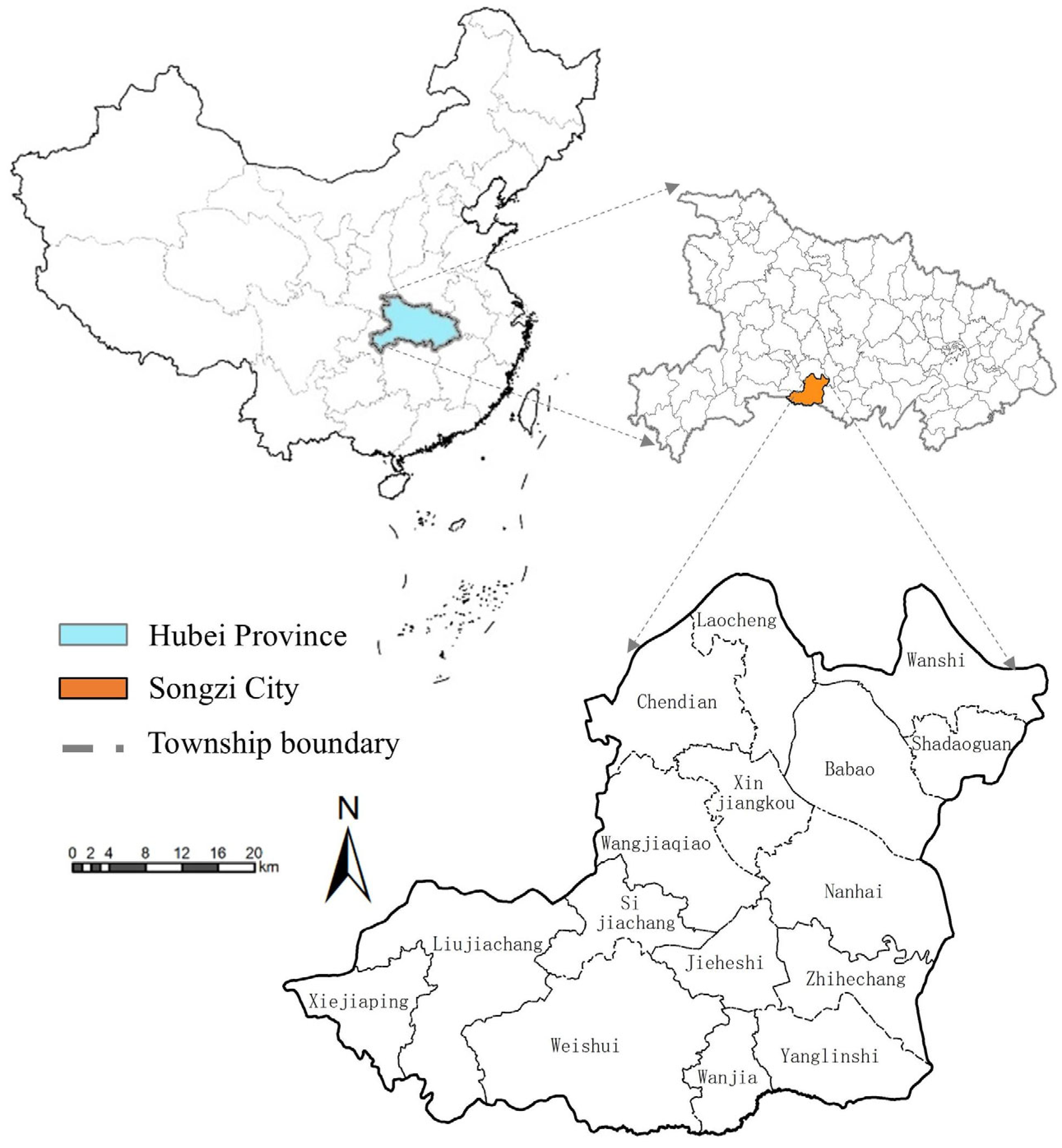
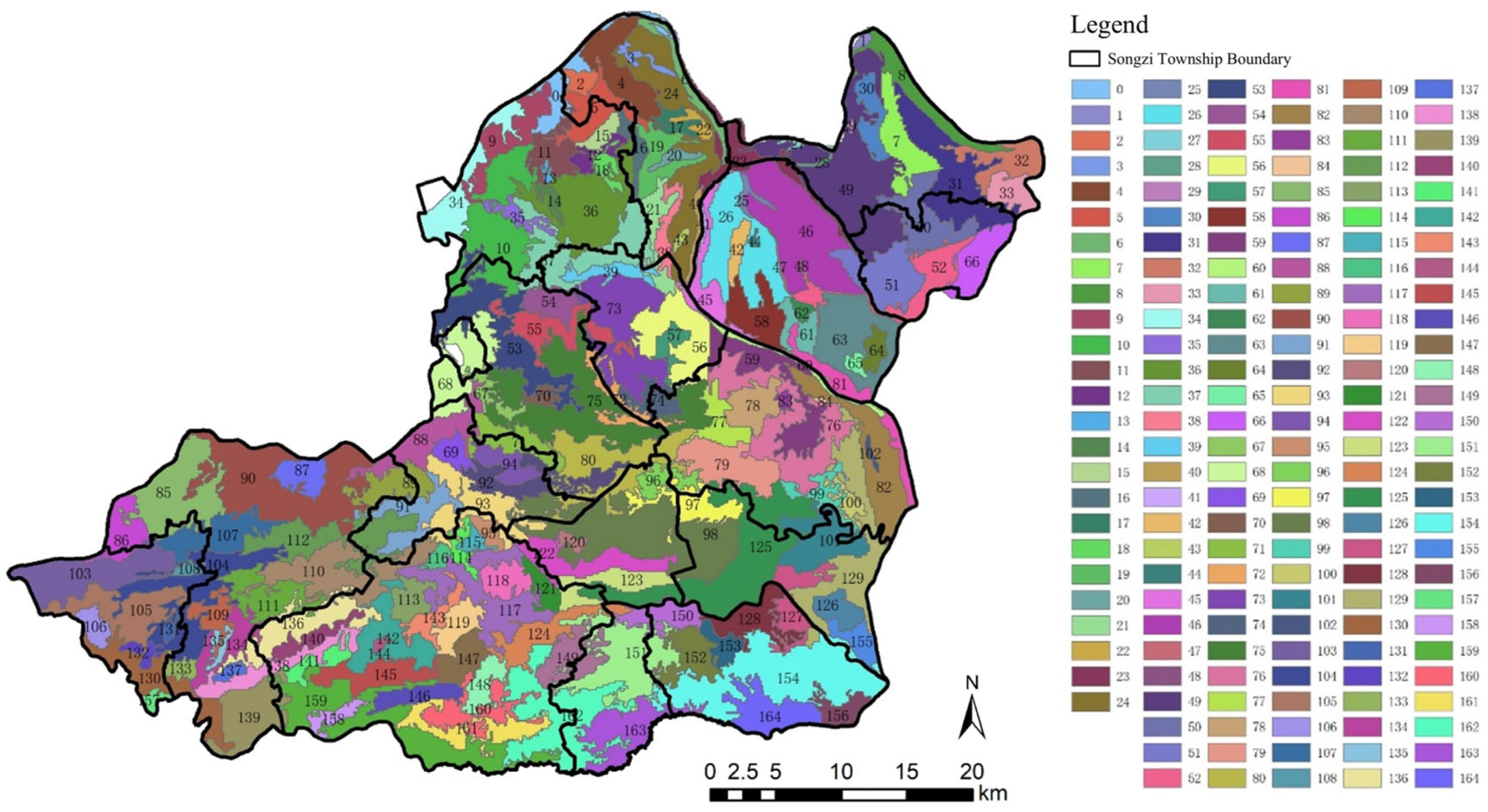
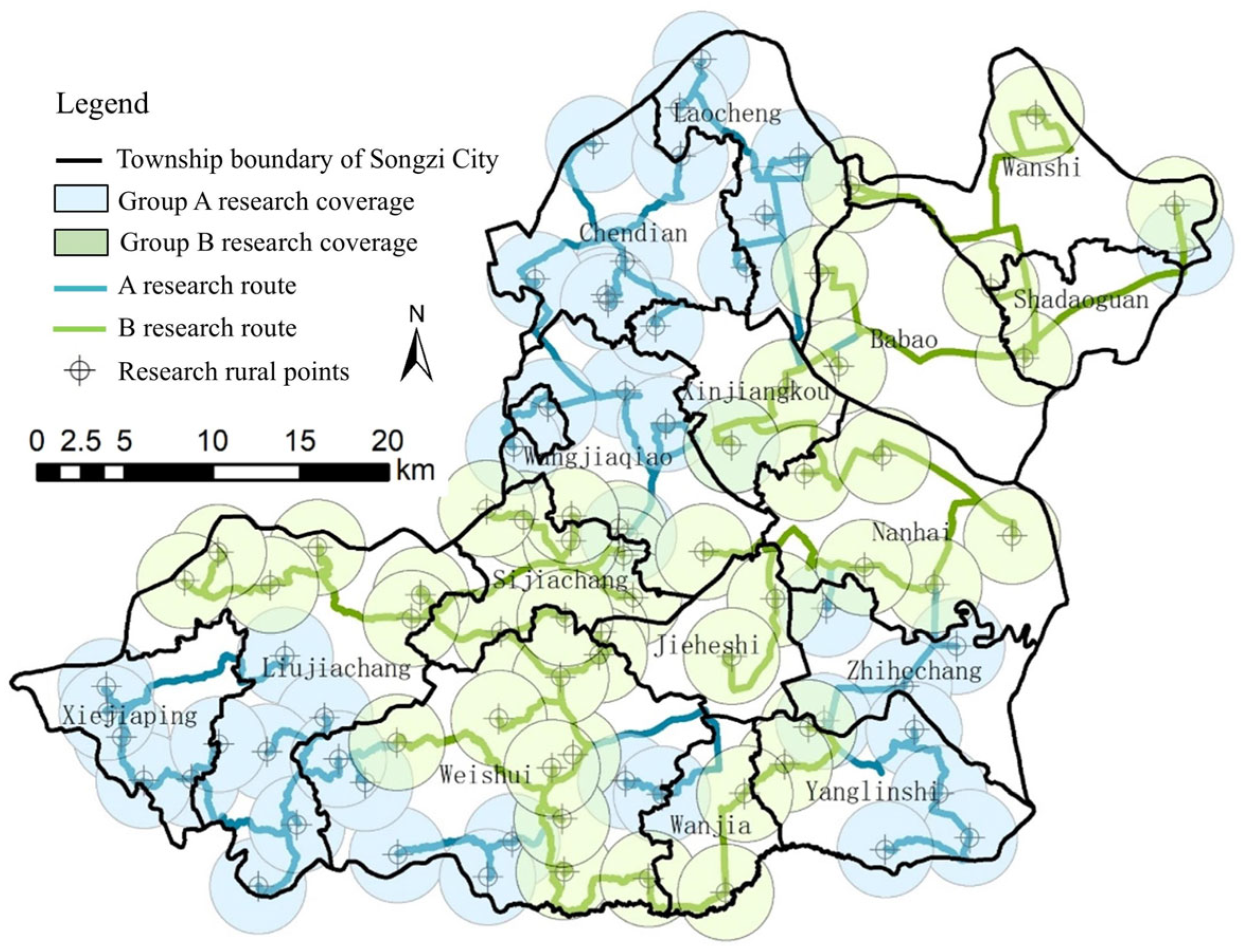

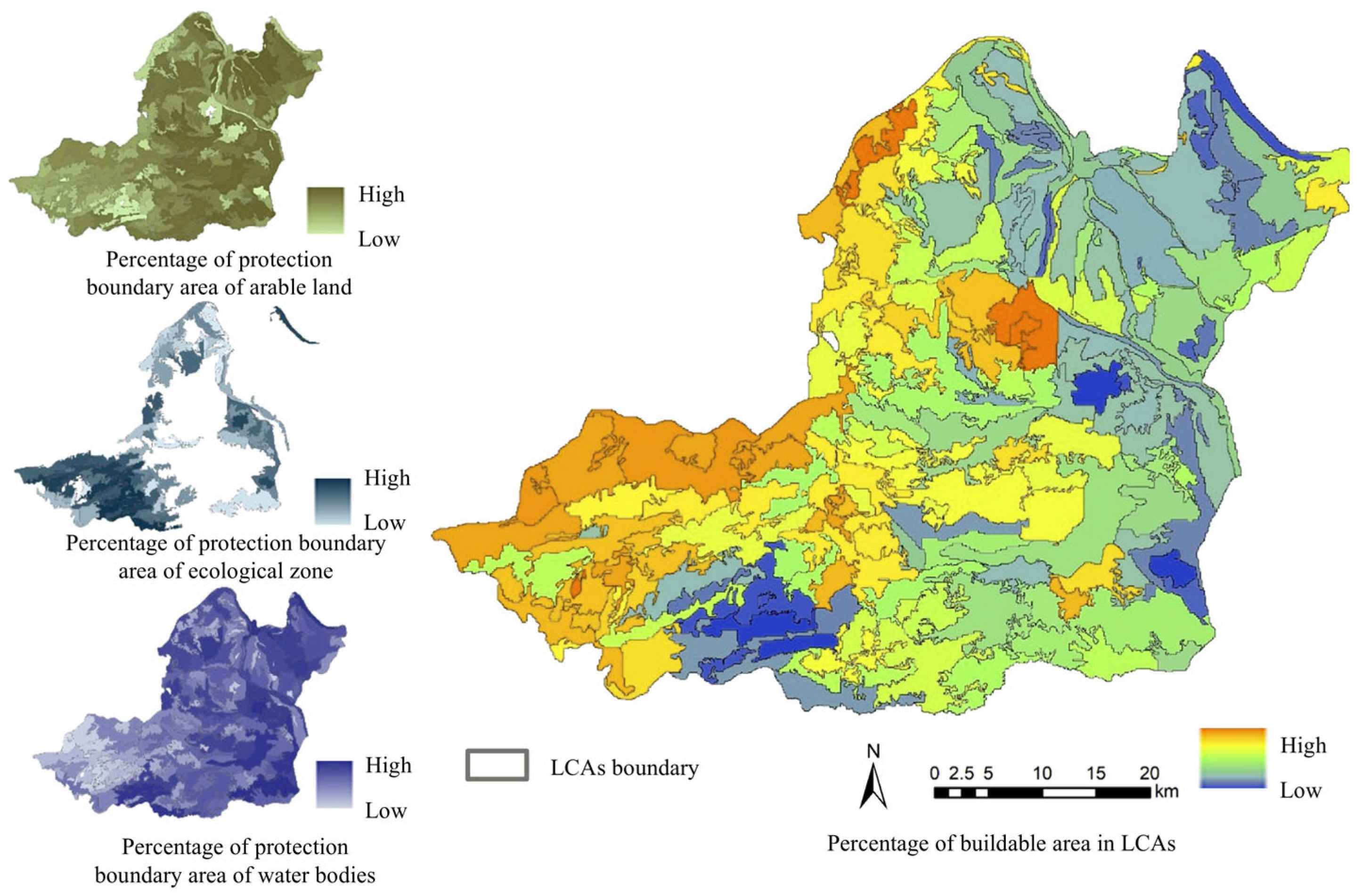

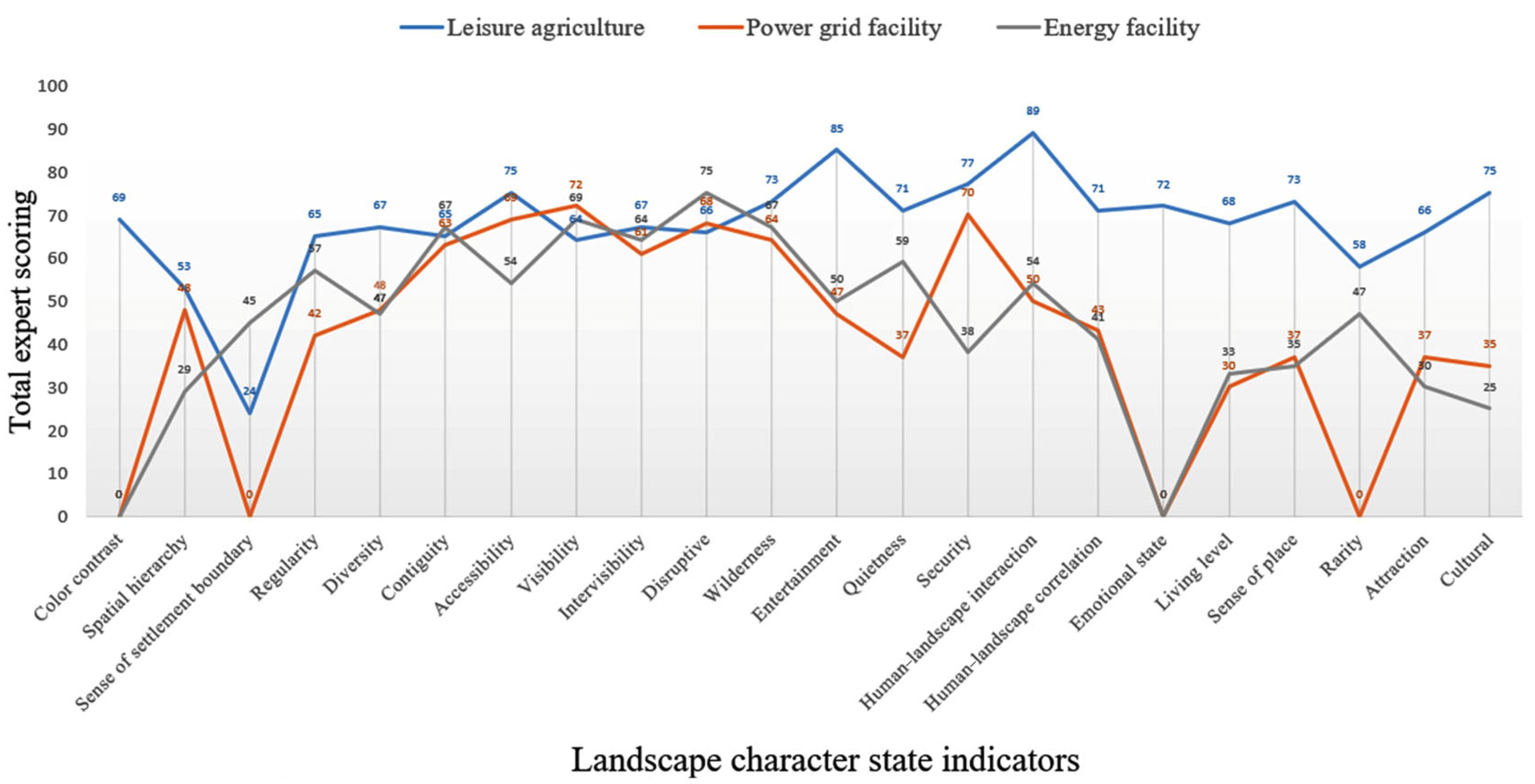
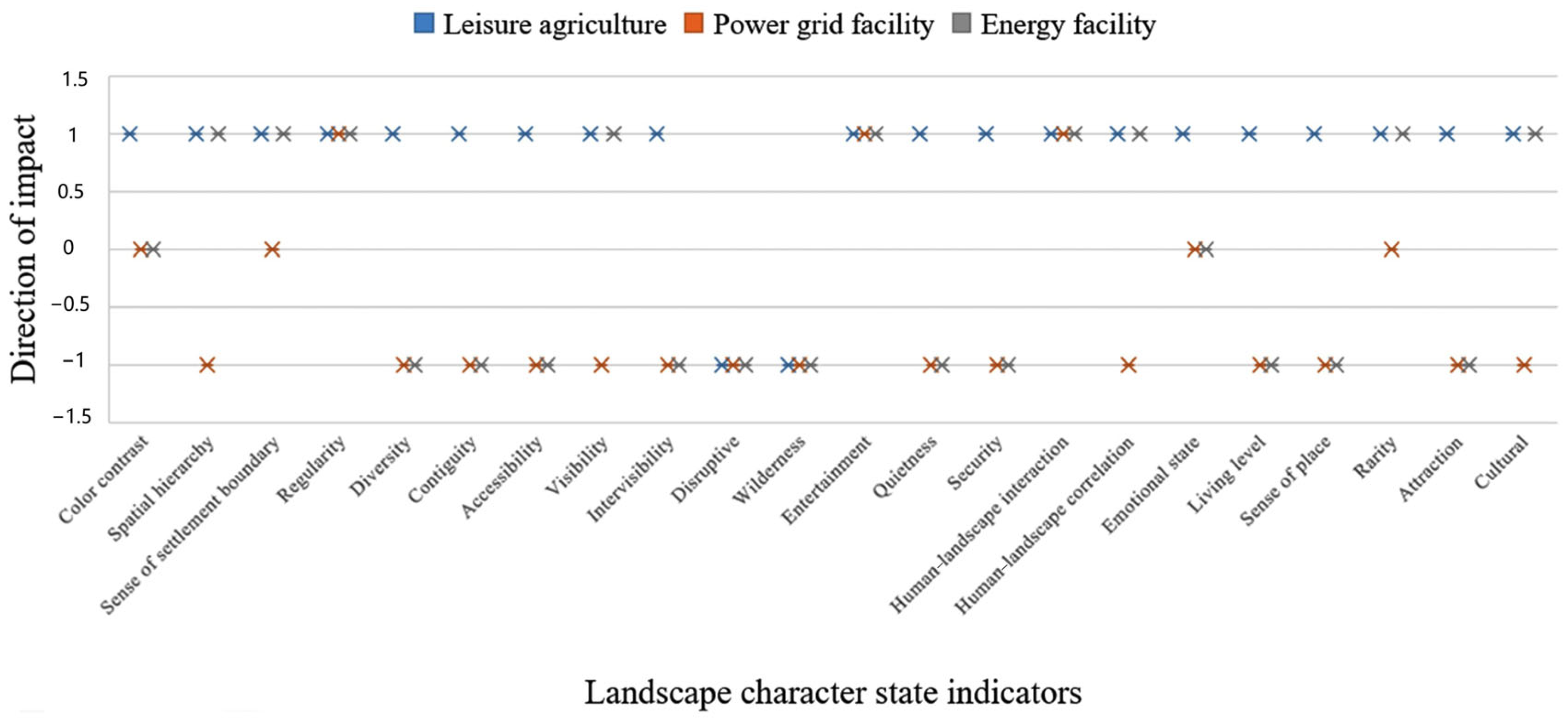
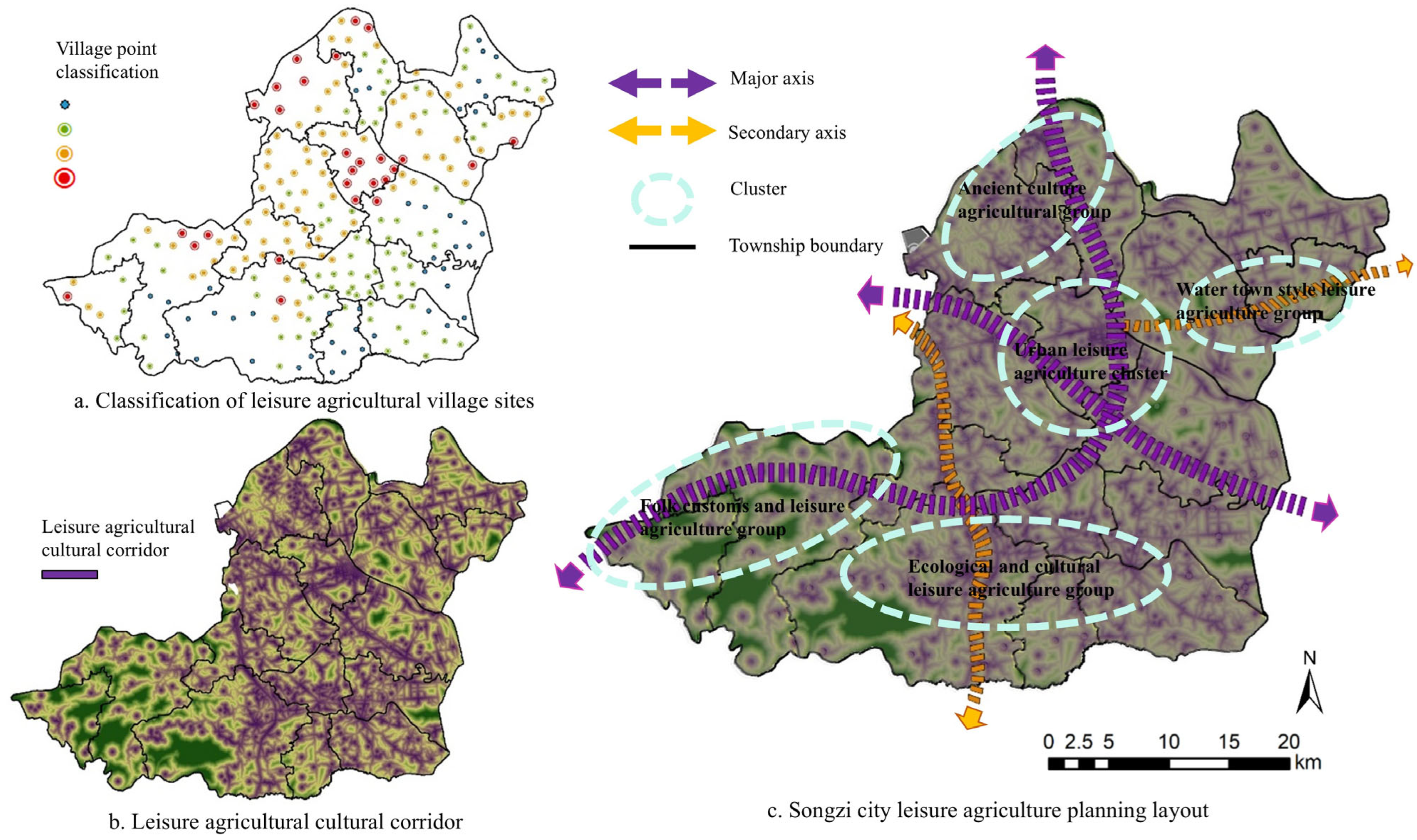
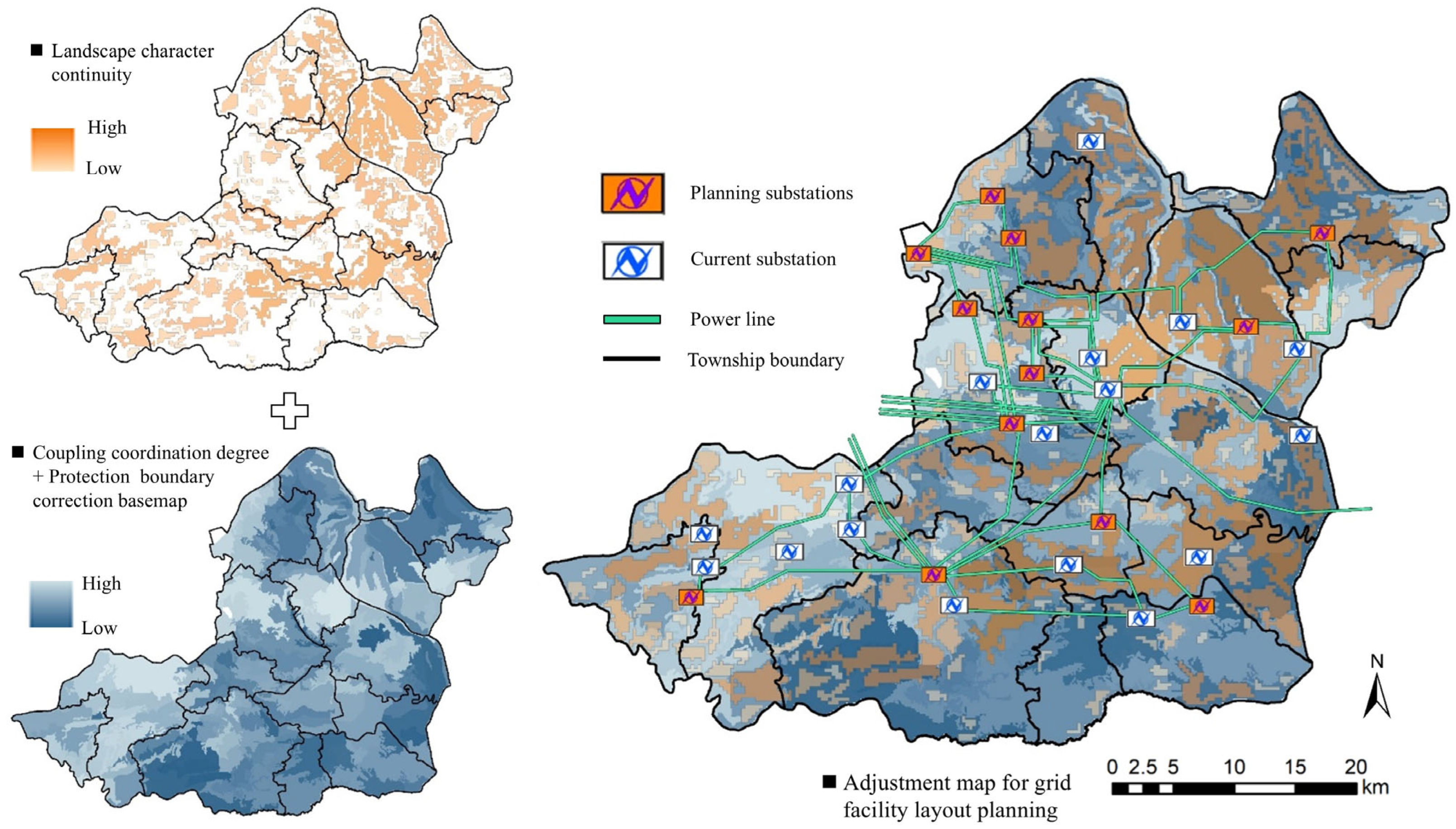
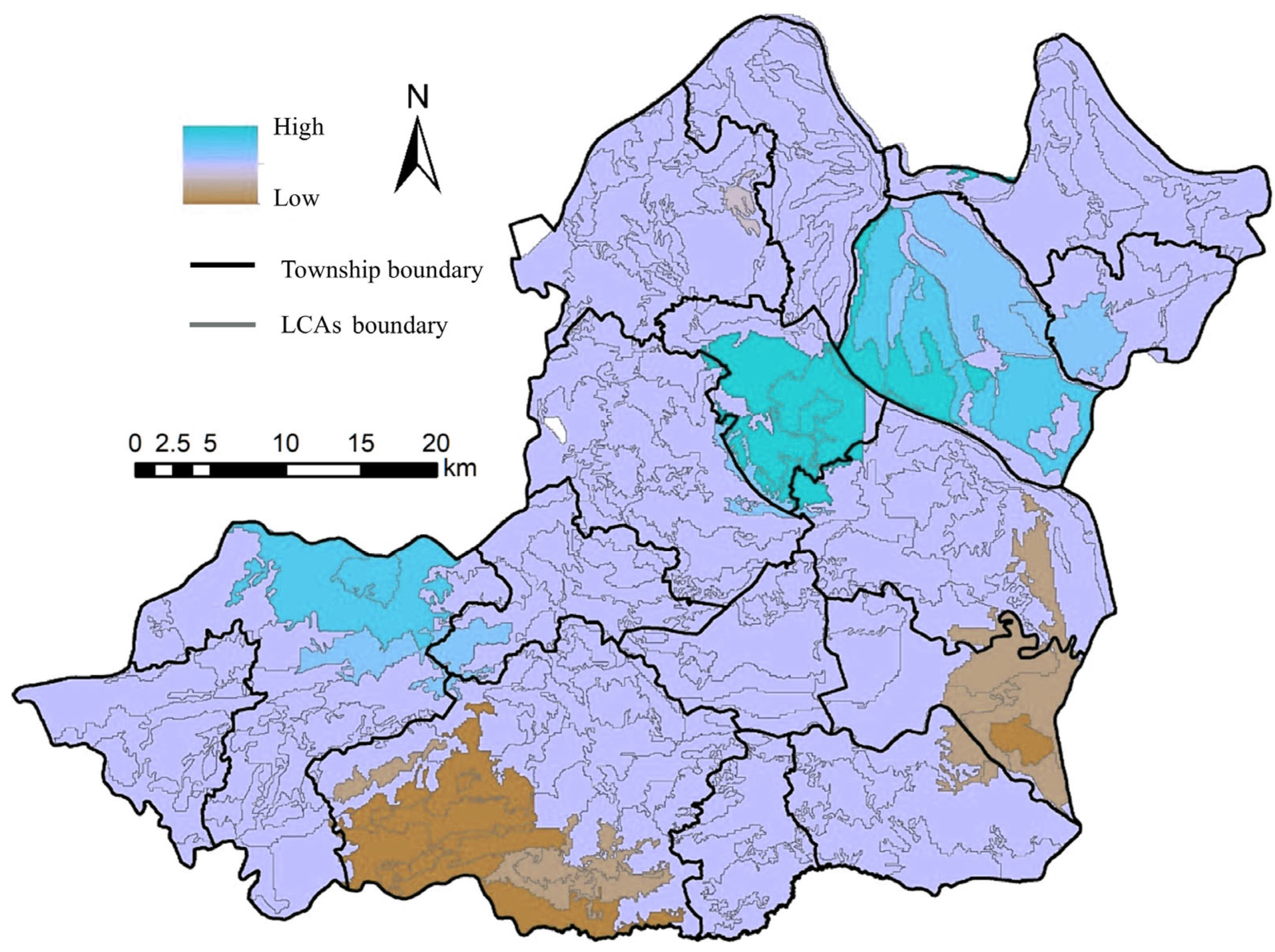
Disclaimer/Publisher’s Note: The statements, opinions and data contained in all publications are solely those of the individual author(s) and contributor(s) and not of MDPI and/or the editor(s). MDPI and/or the editor(s) disclaim responsibility for any injury to people or property resulting from any ideas, methods, instructions or products referred to in the content. |
© 2025 by the author. Licensee MDPI, Basel, Switzerland. This article is an open access article distributed under the terms and conditions of the Creative Commons Attribution (CC BY) license (https://creativecommons.org/licenses/by/4.0/).
Share and Cite
Wu, Y. Spatial Compatibility of Landscape Character State Assessment and Development Projects at County Scale: The Case of Songzi City, China. Land 2025, 14, 1019. https://doi.org/10.3390/land14051019
Wu Y. Spatial Compatibility of Landscape Character State Assessment and Development Projects at County Scale: The Case of Songzi City, China. Land. 2025; 14(5):1019. https://doi.org/10.3390/land14051019
Chicago/Turabian StyleWu, Yunong. 2025. "Spatial Compatibility of Landscape Character State Assessment and Development Projects at County Scale: The Case of Songzi City, China" Land 14, no. 5: 1019. https://doi.org/10.3390/land14051019
APA StyleWu, Y. (2025). Spatial Compatibility of Landscape Character State Assessment and Development Projects at County Scale: The Case of Songzi City, China. Land, 14(5), 1019. https://doi.org/10.3390/land14051019






